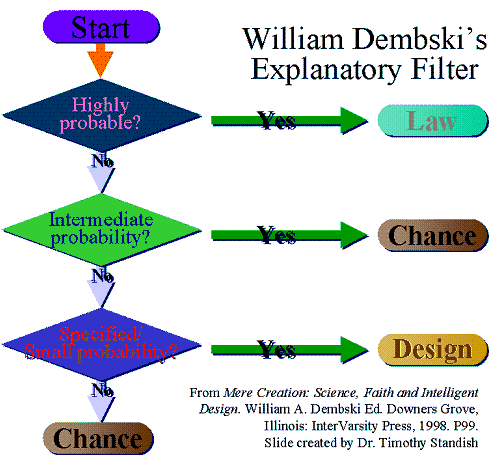FAQ:
How do we Detect Design?
どのようにデザインを検出するのか?
The Short Answer:
We detect design by looking for the tell-tale signs that an intelligent agent acted. Intelligent agents tend to produce specified complexity when they act. We can then seek to detect design by looking for that specified complexity. Using an "explanatory filter" helps us to use normal logic to infer where design was a cause involved in creating an object. Design also could makes other predictions which can also help us to detect design.
我々は、インテリジェントエージェントが何かをしたという隠しおおせない徴候を探すことで、デザインを検出する。インテリジェントエージェントが働くとき"指定された複雑さ"を生産する傾向がある。なので、我々は"指定された複雑さ"をさがすことで、デザインを検出できる。"説明フィルタ"を使えば、その物の創造においてデザインが原因として含まれるかを推論する普通の論理が使える。(インテリジェント)デザインはまたデザインを検出できやすくする他の予言も可能である
The Long Answer:
When intelligent agents act they produce specified complexity. We know this because we understand that when intelligent agents act, they use choice. An essay by William Dembksi lays out in detail how we can understand the products of intelligent design by examining how designers work:
インテリジェントエージェントが働くとき、"指定された複雑さ"を作りだす。インテリジェントエージェントが働くとき、選択を使うことを我々は理解しているので、我々はこれを知っている。William Dembskiのエッセイでは、デザイナーの働き方を調べることで、インテリジェントデザインの産物を我々がいかに理解することができるかを詳細に語っている
To see why CSI [complex-specified information] is a reliable indicator of design, we need to examine the nature of intelligent causation. The principal characteristic of intelligent causation is directed contingency, or what we call choice. Whenever an intelligent cause acts, it chooses from a range of competing possibilities. This is true not just of humans, but of animals as well as extra-terrestrial intelligences. A rat navigating a maze must choose whether to go right or left at various points in the maze. When SETI (Search for Extra-Terrestrial Intelligence) researchers attempt to discover intelligence in the extra-terrestrial radio transmissions they are monitoring, they assume an extra-terrestrial intelligence could have chosen any number of possible radio transmissions, and then attempt to match the transmissions they observe with certain patterns as opposed to others (patterns that presumably are markers of intelligence). Whenever a human being utters meaningful speech, a choice is made from a range of possible sound-combinations that might have been uttered. Intelligent causation always entails discrimination, choosing certain things, ruling out others. Given this characterization of intelligent causes, the crucial question is how to recognize their operation. Intelligent causes act by making a choice.
CSI(複雑で指定された情報)が何故にデザインの信頼できる指標であるのかを見るために、我々はインテリジェントな因果関係の性質を調べる必要がある。インテリジェントな原因の主たる特徴は、方向性を持つ偶発性、あるいは我々が選択と呼ぶものである。インテリジェントな因果関係が働くときはいつでも、競合する複数の可能性の中から選択する。これは人間のみについて正しいのではない。動物でも異星人でも同様である。迷路を進むネズミは、迷路のあらゆるポイントで右へ行くか左へ行くか選択する。SETI(地球外知性探査)の研究者はモニタしている地球外電波からインテリジェンスを見つけようとするとき、地球外のインテリジェンスが送信可能な電波の任意の数を選択可能だと仮定し、インテリジェンスの指標となるパターンを観測している電波の中から見つけようとする。人間が意味のある言葉を話すときはいつでも、選択は発音可能な音の組合せからなされる。インテリジェントな原因は常に区別と特定のものの選択とそれ以外の排除を伴う。このインテリジェントな原因の性質のものでは、その活動をどうやって認識するかが重要な問題となる、インテリジェントな原因は選択によって働く。
CSI is a reliable indicator of design because its recognition coincides with how we recognize intelligent causation generally. In general, to recognize intelligent causation we must establish that one from a range of competing possibilities was actualized, determine which possibilities were excluded, and then specify the possibility that was actualized. What's more, the competing possibilities that were excluded must be live possibilities, sufficiently numerous so that specifying the possibility that was actualized cannot be attributed to chance. In terms of probability, this means that the possibility that was specified is highly improbable. In terms of complexity, this means that the possibility that was specified is highly complex. All the elements in the general scheme for recognizing intelligent causation (i.e., Actualization-Exclusion-Specification) find their counterpart in complex specified information-CSI. CSI pinpoints what we need to be looking for when we detect design.
我々がインテリジェントな因果関係を一般に認識する方法が同時にデザインを認識する方法なので、CSIはデザインの信頼できる指標である。一般に、インテリジェントな因果関係を認識するには、現実化しうる競合する可能性をすべて挙げて、否定できる可能性を除外して、現実化する可能性を指定する必要がある。さらに、十分に起きる可能性が大きいものを除外し、残すのは偶然では現実化しえないものでなければならない。これは指定された可能性が確率的にほとんどありえないことを意味する。複雑さについて言えば、これは指定された可能性が高度に複雑であることを意味する。インテリジェントな因果関係を認識する単に必要な方法の要素(現実化・除外・指定)は、複雑に指定された情報CSIに対応するものがある。CSIはデザイン検出に当たって見つけるべきものを特定する。
In summary, Dembski notes that intelligent agents can choose from one of many competing possibilities. If the choice made is unlikely to occur and sufficiently complex, then we can attribute that choice to design. This comes from our understanding of how intelligent agents operate--not from a negative argument against evolution. In The Design Inference, Dembski lays out a three-part "user-friendly" explanatory filter which we can use to detect intelligent design:
まとめると、Dembskiはインテリジェントエージェントは多くの競合する可能性から一つを選択する能力を持っていると書いている。為された選択が起きそうにないものであり、十分に複雑であるなら、我々はその選択をデザインによるものだと考えられる。これはインテリジェントエージェントがいかに働くかについての我々の理解によるものであって、進化論に対するnegative argumentによるものではない。"The Design Inference"で、Dembskiは、インテリジェントデザインを検出するための、3ステップの使いやすい説明フィルタを提示している。

This explanatory filter recognizes that there are three causes for things: chance, law and design. The premise behind the filter is the positive prediction of design that designers tend to build complex things with low probability that correspond to a specified pattern. In biology, this could be an irreducibly complex structure which fulfills some biological function. This filter helps ensure that we detect design only when it is warranted. If something is high probability, we may ascribe it to a law. If something is intermediate probability, we may ascribe it to chance. But if it is specified and low probability, then this is the tell-tale sign that we are dealing with something that is designed. In these high information-situations, intelligent design theorist Stephen C. Meyer also emphasizes why intelligent design is the right explanation:
この説明的なフィルタは、3つの原因、偶然と法則とデザインを認識する。フィルタの背後にある命題は「デザイナーは指定されたパターンに対応する可能性が小さい複雑なものを作る傾向がある」というデザインについてのポジティブな予測である。生物学においては、生物学的機能を実現する還元不可能に複雑な構造がこれにあたる。この説明フィルタは我々が検出したデザインが本物であることを保証する。あるものが確率的に大きければ自然法則で、中くらいなら偶然だと考える。しかし、指定され、小さな確率であれば、それは我々がデザインされたものと対処しているという、隠しおおせない兆候である。この高度情報の状況で。インテリジェントデザイン理論家Stephen C. Meyerは何故インテリジェントデザインが正しい説明であるかを強調する。
"Experience teaches that information-rich systems … invariable result from intelligent causes, not naturalistic ones. Yet origin-of-life biology has artificially limited its explanatory search to the naturalistic nodes of causation … chance and necessity. Finding the best explanation, however, requires invoking causes that have the power to produce the effect in question. When it comes to information, we know of only one such cause. For this reason, the biology of the information age now requires a new science of design.
我々は経験から、情報を豊富に持つシステムは自然な原因ではなくインテリジェントな原因の不変の結果であることを知っている。しかし、生命の起源について生物学は、人為的に説明の探求範囲を自然主義な因果関係すなわち偶然と必然に限定している。最良の説明を見つけるには、しかし、問題に回答できる力を持つ原因を考慮する必要がある。情報について言えば、我々はたった一つの原因を知っている。この理由により、情報時代の生物学はデザインの新しい科学を必要としている。
[Stephen C. Meyer, Mere Creation, pg. 140]
"Indeed, in all cases where we know the causal origin of 'high information content,' experience has shown that intelligent design played a causal role."
「我々が因果的起源を知っている高度情報のすべての例で、我々は因果関係においてインテリジェントデザインが役割を担っていることを経験として知っている。
"Intelligent design provides a sufficient causal explanation for the origin of large amounts of information, since we have considerable experience of intelligent agents generating informational configurations of matter."
「インテリジェントデザインは、膨大量の情報の因果的起源の十分な説明を与える。というのは我々はものの情報構成をインテリジェントエージェントが作成する経験を十分に持っているからだ。
[Meyer S. C. et. al., "The Cambrian Explosion: Biology's Big Bang," in Darwinism, Design, and Public Education, edited by J. A. Campbell and S. C. Meyer (Michigan State University Press, 2003]
Intelligent design is thus a cause sufficient to produce the high levels of information, i.e. irreducible complexity, found in biology. Intelligent design is not merely a negative argument against evolution, but is inferred because of its positive predictions of how we understand designers to operate.
したがって、インテリジェントデザインは、生物学に見つかる還元不可能な複雑さのおうな高度情報を作るに十分な原因である。
Kumicitのコメント
このFAQの項目は、前半が上記の説明フィルタ、後半が仮説演繹もどきになっている。ここでは「説明フィルタ」部分のみ訳出
「説明フィルタ(explanatory filter)」はこれがすべてである。数式もプログラムも存在しない。「偶然でも自然法則でもないものはデザインだ」という、非常に明瞭な"God of the gaps"型の論である。
最終更新:2010年02月19日 08:38
